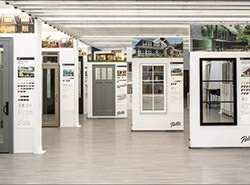New Windows Support Historic Preservation at Cincinnati Church
A window restoration project brings modern performance to a landmark sanctuary without sacrificing historic character.
Project Details
Project Type:
Commercial Window Replacement
Building Type:
Community
Location:
Cincinnati, OHProducts Used:
Mt. Auburn Presbyterian Church is a cornerstone of its Cincinnati neighborhood—known for its Romanesque stone façade, rose window and intricately arched fenestration. When it came time to update the church’s aging windows, preserving those defining details was a top priority.
To meet the structural and aesthetic demands of this legacy build, the project team selected Pella Reserve wood windows. This product line offers architect-grade detailing with through-stile construction, concealed jamb liners and customizable grille profiles—all critical for matching the original look of the building. For deeper masonry surrounds and compound arches, each unit was custom-built to match original sizes, shapes and sightlines.
Energy-Efficient Commercial Windows That Preserve Historic Integrity
In historic window replacement projects, performance upgrades must be achieved without compromising architectural intent—a balance that requires precision and thoughtful material selection. For Mt. Auburn Presbyterian Church, Pella Reserve windows delivered exactly that.
Each unit features dual-pane Low-E insulating glass, helping regulate interior temperatures year-round while reducing solar heat gain and outside noise—key considerations for maintaining comfort during worship services, choir rehearsals and community events.
The extruded aluminum-clad exteriors provide superior resistance to weather, corrosion and UV exposure, standing up to Cincinnati’s seasonal shifts without frequent maintenance. Inside, wood interiors were selected to complement the sanctuary’s warm, historic finish palette, creating visual continuity from the original construction.
Because the church’s windows are set in deep masonry openings—many of them arched—Pella’s team custom-fabricated each window to match original dimensions and sightlines. This ensured a seamless fit that required minimal disturbance to the surrounding structure, helping avoid delays or added costs related to wall or trim reconstruction.
For pros managing historic commercial window replacement projects, Pella Reserve offers a rare combination: architectural authenticity, code-compliant performance and long-term durability in a package that’s backed by responsive commercial support.
Precision Window Solutions for Historic Commercial Retrofits
Retrofitting windows in legacy structures requires more than off-the-shelf solutions—it demands products that respect original architecture while meeting modern expectations. For historic commercial window replacement projects like Mt. Auburn Presbyterian Church, Pella Reserve offered the ideal combination of craftsmanship and configurability.
Working closely with architect John Adams, our Pella team helped replicate key design details—including arched tops, custom grille patterns and deep-set frames—while integrating modern insulating glass and durable aluminum cladding. Every window was custom-fabricated to match existing masonry openings, helping maintain sightlines and symmetry across the church’s highly visible façade.
The Reserve series’ through-stile construction and concealed jamb liners also allowed for clean, uninterrupted profiles—an important feature when preserving the building’s original Romanesque character.
Streamlined Execution with Commercial-Grade Performance
Beyond design fidelity, Mt. Auburn’s phased installation required tight coordination and reliable field support. Pella Cincinnati’s commercial team helped align delivery timelines, verify on-site measurements and resolve structural nuances, keeping the project moving without disrupting church operations.
Pella Reserve windows are engineered and tested to meet commercial-grade performance needs, including thermal efficiency, structural integrity and air infiltration standards. This allows contractors to meet energy codes and performance specs, even in preservation projects.
For trade and project managers, that means fewer delays, fewer call-backs and the confidence that comes from partnering with a team that understands the complexities of commercial retrofits—especially in historically sensitive environments.


